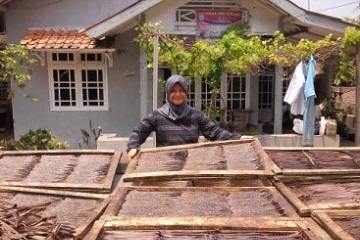IPB Researchers Found Ways for Eel to Approach 100 Percent Survival Rate

For decades, Indonesian people as well as Asian ethnic used the rice field eel, Monopterus albus, as a delicious food from the nature. Increasing the necessities of life, both for the fulfillment of nutrition and family income, encouraging the rice field eel become economically valuable, consumed and traded commodities in local, national and international markets.
Market demand for eel is continue to increase. While its population decreases due to pollution and depreciation of rice fields. A researcher from the Department of Aquaculture, Faculty of Fisheries and Marine Sciences, Bogor Agricultural University (FPIK IPB), Dr. Yani Hadiroseyani explains that the supply of eels in the food market generally comes from the wild stock of natural waters and rice fields. "But in the last ten years the eel catch tends to decline due to habitat destruction, water pollution and excessive use of pesticides," said Yani.
The situation ultimately encourages farmers to develop fish farming activities to be the same with what is done in China, Thailand, and Vietnam. In Indonesia, eel is cultivated traditionally in ponds with soil substrate covered by shallow water since 1986. But there is no success stories reported so far.
Dr. Yani explains that since 1979 eels have been traditionally cultivated in drum-tanks filled with mud mixtures as its artificial habitat. But until now the harvest has not given optimal results due to the very low eel survival rate. Experiments still continue to be done to produce the best method in eel farming.
Recently, research on cultivation of eels in clear water is done to facilitate the better cultivation process and fish monitoring compared to traditional method. Yani and her team tried to cultivate eel on clean water system without mud. From the experiment, the high survival rate of 90 to 100 percent was obtained with the addition of salt in maintenance water.
"Increasing salinity to 9 grams per liter reduces the osmotic gradient of eel to the isosmotic level and prevents leakage of blood sodium. Since the addition of salt will increase the production cost, the recirculation system should be applied to the culture tank to minimize the use of salt and to reduce the volume water effectively. This system has also proven to support high density up to 55 grams per liter with 90 percent survival after nine months of cultivation period, "she said.
Various other experiments have also been reported as conducted by Rahmat in 2016. Eel cultivation in the water medium obtain 93-96 percent survival with the addition of 3-9 grams of salt per liter with water change. Similarly, Herwanti 2017 cultivated eel in the recirculation system to achieve 99 percent survival with sea water dilution at 9 grams per liter. The cultivation system in a water pond without mud can be applied to rice eels using a recirculation system. It can also produce high eel survival efficiently. (TK)



